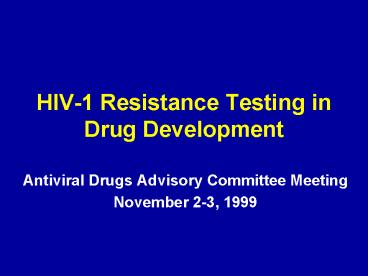HIV1 Resistance Testing in Drug Development - PowerPoint PPT Presentation
1 / 15
Title:
HIV1 Resistance Testing in Drug Development
Description:
Susan Little. Richard D'Aquila. FDA. Jeff Murray. Girish Aras. Narayana Battula. Debra Birnkrant ... Richard Klein. Katherine Laessig. Jonathan Ma. Lalji ... – PowerPoint PPT presentation
Number of Views:233
Avg rating:3.0/5.0
Title: HIV1 Resistance Testing in Drug Development
1
HIV-1 Resistance Testing in Drug Development
- Antiviral Drugs Advisory Committee Meeting
- November 2-3, 1999
2
Introduction
- Implications of HIV drug resistance
- Patient management perspective
- Drug development perspective
- Meeting Goals
- Origin of meeting
- Session objectives
- Acknowledgments
3
Implications of HIV Drug Resistance (1)
- Clinical Management Perspective
- Critical factor affecting safe and effective use
of therapeutics for HIV - One of the important causes of treatment failure
- Limits options for alternative regimens
- Exposes patients to risk of drug-induced toxicity
without potential benefit - Public health problem of transmission of
resistant virus raises additional issues
4
Implications of HIV Drug Resistance (2)
- Drug Development Perspective
- Complicates interpretation of trial results
- Limited understanding of why patients respond or
fail combination therapy in clinical trials - Limits ability to test new drugs in patient
population with greatest need (heavily
pretreated) - Limits ability to provide advice on the optimal
use of a new drug in labeling
5
What are some current limitations?
- Diverse methodologies in genotypic and phenotypic
testing uncertain correlation - No approved assays
- No uniform requirements for resistance
characterization in drug development or
post-marketing - Lack of consensus regarding clinical utility and
interpretation of testing - Incomplete understanding of relationship with
cofactors
6
HIV Resistance Testing in Drug Development
Meeting Goals
- Define what is known and what needs further study
- Reliability of assays, interpretation of results,
and strength for predicting treatment outcome - Discuss approaches for defining resistance
(mutational algorithms, breakpoints) now, and in
the future - Discuss standardized methods for analyzing data
- Obtain guidance on use of resistance testing in
drug development - Discuss what future initiatives should be
undertaken to encourage progress
7
Development of Meeting
- Charge from Advisory Committee Chair
- Identification of some common goals with
industry-sponsored HIV Resistance Collaborative
Group - Broader solicitation of relevant information and
perspective - Iterative approach to developing agenda (issue
identification was a goal in itself!)
8
HIV Resistance Collaborative GroupRepresentation
- Pharmaceutical companies
- Diagnostic companies
- ACTG virology/statistics/clinical trials
- Academicians
- European Health Authorities
- FDA (CDER, CBER, CDRH)
- Community
9
Federal Register Announcement
- Notification of meeting
- Request for
- Data on the relationship of HIV mutation
development and changes in susceptibility - Prospective or retrospective data on relationship
between genotype or phenotype and clinical
outcome - Proposals for resistance testing in clinical
trials - Proposals for product labeling claims
10
Meeting Format
- Scientific workshop
- Not product specific
- No voting issues
- Modular
- Each session has specific objectives and points
for committee discussion - Invited presentations selected to provide
relevant background for discussion - Common theme for each session recommendations
for progress
11
Objectives - Session 1Resistance Technology
- General principles, and exploration of
performance characteristics of currently
available genotypic phenotypic assays - Limitations
- Quality control issues
- Correlation between genotype and phenotype
- Role of assays in drug development
- Update on proposed approach to assay regulation
(CBER)
12
Objectives - Session 2Clinical Validation
- Explore predictive value of baseline genotype or
phenotype and treatment outcome - Prospective trials
- Retrospective analyses using a common analysis
plan - Discuss approaches for categorizing and analyzing
resistance patterns - Identify additional clinical research to further
define clinical utility
13
Objectives - Session 3Practical Considerations
- Identify patient populations for whom resistance
testing in drug development is most useful - Explore other factors to consider when resistance
testing is incorporated into clinical trials
14
Objectives - Session 4Potential Roles in Drug
Development
- Obtain guidance on in vitro and clinical data
necessary to characterize resistance and
cross-resistance potential - Obtain guidance on post-marketing evaluation of
resistance - Feedback on potential scenarios for use of
resistance testing to support regulatory claims
15
Acknowledgments
- HIV Resistance Collaborative Group
- Invited Speakers
- Douglas Richman
- Phillipe Clevenbergh
- John Baxter
- John Mellors
- Victor DeGruttola
- Michael Para
- Mounir Ait-Khaled
- Veronica Miller
- Susan Little
- Richard DAquila
- FDA
- Jeff Murray
- Girish Aras
- Narayana Battula
- Debra Birnkrant
- Gary Chikami
- Andrew Dayton (CBER)
- Walla Dempsey
- Tom Hammerstrom
- Lauren Iacono-Connors
- Richard Klein
- Katherine Laessig
- Jonathan Ma
- Lalji Mishra
- Joanne Rhoads
- Rhonda Stover
- Kim Struble
- Joseph Toerner

